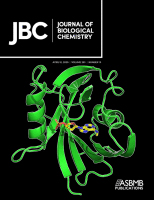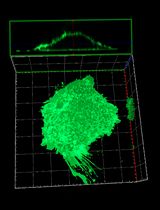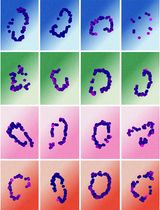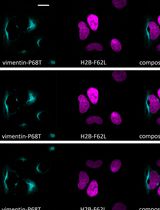- EN - English
- CN - 中文
Live Cell FRET Analysis of the Conformational Changes of Human P-glycoprotein
人P-糖蛋白构象变化的活细胞FRET分析
发布: 2021年02月20日第11卷第4期 DOI: 10.21769/BioProtoc.3930 浏览次数: 5113
评审: Mario RuizHongwei HanAnonymous reviewer(s)
Abstract
The molecular mechanisms of P-glycoprotein (P-gp; also known as MDR1 or ABCB1) have been mainly investigated using artificial membranes such as lipid-detergent mixed micelles, artificial lipid bilayers, and membrane vesicles derived from cultured cells. Although these in vitro experiments help illustrate details about the molecular mechanisms of P-gp, they do not reflect physiological membrane environments in terms of lateral pressure, curvature, constituent lipid species, etc. The protocol presented here includes a detailed guide for analyzing the conformational change of human P-gp in living HEK293 cells by using intramolecular fluorescence resonance energy transfer (FRET), in which excitation of the donor fluorophore is transferred to the acceptor without emission of a photon when two fluorescent proteins are in close proximity. Combining FRET analysis with membrane permeabilization, the contribution of small molecules such as nucleotides to the conformational change can be evaluated in living cells.
Keywords: Live cell analysis (活细胞分析)Background
P-glycoprotein (P-gp) is an ATP-driven multidrug transporter that extrudes various hydrophobic toxic compounds to the extracellular space. P-gp consists of two transmembrane domains (TMDs) that form the substrate translocation pathway and two nucleotide-binding domains (NBDs) that bind and hydrolyze ATP. At least two P-gp states are required for the transport. In the inward-facing (pre-drug transport) conformation, the two NBDs are separated, and the two TMDs are open to the intracellular side; in the outward-facing (post-drug transport) conformation, the NBDs are dimerized, and the TMDs are slightly open to the extracellular side (Kodan et al., 2020). Since the discovery of P-gp (Juliano and Ling, 1976; Chen et al., 1986; Ueda et al., 1986), numerous studies have been conducted to clarify its transport mechanism. Most have utilized artificial membrane environments such as lipid-detergent mixed micelles (Kodan et al., 2014 and 2019; Verhalen et al., 2017), artificial lipid bilayers (Verhalen et al., 2012; Moeller et al., 2015; Zoghbi et al., 2017; Dastvan et al., 2019), or membrane vesicles derived from cells overexpressing P-gp (Liu and Sharom, 1996; Qu and Sharom, 2001). However, these conditions do not reflect physiological membrane environments in terms of lateral pressure, curvature, or constituent lipid species. Because these environmental factors can affect the function of P-gp, the detailed transport mechanism should be investigated in living cells. Accordingly, a conformation-sensitive monoclonal antibody, UIC2, has been used (Bársony et al., 2016). However, because UIC2 binds to the extracellular loops of the inward-facing structure of P-gp, the conformational change of the intracellular side has not been revealed. The distances between the C termini of NBD1 and NBD2 are estimated to be about 30 and 11 Å in the inward-facing and outward-facing structures, respectively (Futamata et al., 2020) and this difference in distance is assumed to be one of the largest between the inward-facing and outward-facing structures. Therefore, we monitored the distance of the two NBDs by FRET analysis. When the donor and acceptor were attached to different domains of the macromolecule, strong FRET occurred when the two domains were in close proximity. The big advantage of FRET analysis is that it can be performed in living cells in real time, which is not true of antibody-based analyses. In this study, two fluorescent proteins, monomeric (m)Cerulean and monomeric (m)Venus, were fused to the N- and C-terminal regions of NBDs, respectively. A change in distance between the two NBDs was evaluated by investigating the sensitized-emission of mVenus (acceptor) elicited during the excitation of mCerulean (donor) in living cells in real time. While the protocol described focuses on human P-gp in living HEK293 cells, it is also applicable to other membrane proteins.
Materials and Reagents
35 mm glass-based dish (IWAKI, catalog number: 3971-035 )
100 mm cell culture dish (Falcon, catalog number: 353003 )
1.5 ml tube (Watson, catalog number: 131-815C )
15 ml tube (Corning, catalog number: CLS430791 )
0.22 μm filter (Millipore, catalog number: SLGP033RS )
Mammalian expression vector that encodes FRET probe (see the beginning of the section Procedure below)
HEK293 cells (ACTT® CRL-1573TM)
Poly-L-lysine (PLL) solution 0.01% (Sigma-Aldrich, catalog number: P4707-50ML )
DMEM (Nacalai Tesque, catalog number: 08458-16 )
0.5% Trypsin-EDTA (10×) (Gibco, catalog number: 15400-054 )
Fetal Bovine Serum (Gibco, catalog number: 10270-106 )
Lipofectamine LTX with PLUS Reagent (Thermo Fisher Scientific, catalog number: 15338100 )
Opti-MEM (1×) (Gibco, catalog number: 2151680 )
FluoroBrite DMEM (Gibco, catalog number: A1896701 )
Sodium pyruvate (100 mM) (Gibco, catalog number: 11360-070 )
GlutaMAX (100×) (Gibco, catalog number: 35050061 )
Verapamil chloride (Wako, catalog number: 228-00783 )
PEI MAX (MW = 40,000) (Polysciences, catalog number: 24765-1 )
Adenosine 5’-triphosphate (ATP) disodium salt (Oriental Yeast, catalog number: 45142000 )
Streptolysin O (SLO) (BioAcademia, catalog number: 01-531 )
DAPI (Sigma-Aldrich, catalog number: D9542-1MG )
NaCl (Nacalai Tesque, catalog number: 31320-05 )
Na2HPO4·12H2O (Nacalai Tesque, catalog number: 31723-35 )
KCl (Nacalai Tesque, catalog number: 28514-75 )
KH2PO4 (Nacalai Tesque, catalog number: 28721-55 )
HEPES (Nacalai Tesque, catalog number: 17514-15 )
KOH (Nacalai Tesque, catalog number: 28616-45 )
CH3COOK (Wako catalog number: 160-03175 )
MgCl2·6H2O (Nacalai Tesque, catalog number: 20909-55 )
Dimethyl sulfoxide (DMSO) (Sigma-Aldrich, catalog number: D2650 )
NaOH (Nacalai Tesque, catalog number: 31511-05 )
PLL solution (see Recipes)
10× PBS(-) (see Recipes)
1× PBS(-) (see Recipes)
10× transport buffer (see Recipes)
1× transport buffer (see Recipes)
0.05% Trypsin-EDTA (see Recipes)
100 mM ATP stock solution (see Recipes)
50 mM verapamil stock solution (see Recipes)
1 mg/ml DAPI stock solution (see Recipes)
100 mM NaN3 stock solution (see Recipes)
1 M MgCl2 stock solution (see Recipes)
1 mg/ml PEI-MAX (see Recipes)
Equipment
Autoclave (TOMY, model: LSX-500 )
Vortex mixer (Scientific Industries, model: VORTEX-GENIE 2 )
Temperature bath (TAITEC, model: SDminiN )
CO2 incubator (Thermo Fisher Scientific, model: Forma 310 Direct Heat CO2 incubator)
Centrifuge (TOMY, model: LC-200 , rotor: TS-7LB)
Cell counter (DeNovix, model: Cell Drop BF )
Confocal laser scanning microscope (Carl-Zeiss, model: LSM700) operated by Zen 2012 and equipped with an objective lens (Plan-Apochromato ×63/1.4 NA oil immersion), an incubation chamber, temperature module S, and CO2 module S.
Software
ImageJ-based Fiji (version 1.52p) (https://imagej.net/Fiji) (Schindelin et al., 2012)
FRET and Colocalization Analyzer
(https://imagej.nih.gov/ij/plugins/fret-analyzer/fret-analyzer.htm) (Hachet-Haas et al., 2006)
Procedure
文章信息
版权信息
© 2021 The Authors; exclusive licensee Bio-protocol LLC.
如何引用
Readers should cite both the Bio-protocol article and the original research article where this protocol was used:
- Futamata, R., Kioka, N. and Ueda, K. (2021). Live Cell FRET Analysis of the Conformational Changes of Human P-glycoprotein. Bio-protocol 11(4): e3930. DOI: 10.21769/BioProtoc.3930.
- Futamata, R., Ogasawara, F., Ichikawa, T., Kodan, A., Kimura, Y., Kioka, N. and Ueda, K. (2020). In vivo FRET analyses reveal a role of ATP hydrolysis-associated conformational changes in human P-glycoprotein. J Biol Chem 295(15): 5002-5011.
分类
生物物理学 > 生物工程
细胞生物学 > 细胞成像 > 荧光
生物化学 > 蛋白质 > 成像
您对这篇实验方法有问题吗?
在此处发布您的问题,我们将邀请本文作者来回答。同时,我们会将您的问题发布到Bio-protocol Exchange,以便寻求社区成员的帮助。
提问指南
+ 问题描述
写下详细的问题描述,包括所有有助于他人回答您问题的信息(例如实验过程、条件和相关图像等)。
Share
Bluesky
X
Copy link












